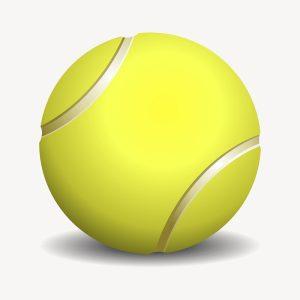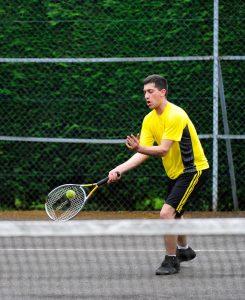We may earn money or products from the companies mentioned in this post.
Who Invented The Tennis Ball: The Origins

The history of the tennis ball can be traced back to ancient ball games that served as predecessors to the modern version we know today These early games laid the foundation for the development of tennis and its equipment
Predecessors of the modern tennis ball
Ancient civilizations such as the Egyptians, Greeks, and Romans played various ball games that involved hitting or throwing a ball While these games differed in rules and techniques, they all contributed to the evolution of sports involving balls
-
Egyptians and their leather balls:
The Egyptians are believed to have used leather balls in their ancient ball games These balls were typically made from animal hides stitched together, providing durability and bounce for gameplay -
Greeks and Romans’ use of wool or hair-filled balls:
The Greeks and Romans introduced wool or hair-filled balls into their athletic activities These softer materials ensured a more controlled game, reducing the risk of injury while maintaining playability
Early forms of tennis and their equipment
Tennis, as we know it today, has its roots in a French game called Jeu de Paume, which emerged in the 12th century This early form of tennis was played with bare hands or gloves used to strike a ball against a wall or over a net
-
Jeu de Paume:
In Jeu de Paume, players utilized palms or gloves to hit the ball during gameplay This handball-like game laid the groundwork for modern tennis techniques -
Balls made from cork, fabric, or leather filled with materials:
In this early stage of tennis, balls were made from a combination of cork, fabric, or leather These materials were filled with substances like sand, clay, or animal hair to provide the necessary weight and bounce for gameplay
The invention of the tennis ball can thus be attributed to the collective innovations and adaptations made by various civilizations throughout history From ancient leather balls to wool or hair-filled spheres, the evolution of tennis equipment has played a crucial role in shaping the game we enjoy today
Evolution of the Tennis Ball Design: Key Innovations Through Time

Tennis is a sport steeped in tradition, with equipment that has evolved significantly over the years One crucial aspect of the game that has undergone remarkable transformations is the tennis ball itself From humble beginnings to cutting-edge innovations, let’s delve into the fascinating journey of tennis ball design
Transition from hand-stitched to machine-pressed balls (17th century)
In the early days of tennis, balls were painstakingly crafted by hand, using layers of fabric stitched together and filled with various materials like animal hair or wool But as the popularity of tennis grew, so did the need for a more efficient manufacturing process
Enter Charles Goodyear, an inventor known for his groundbreaking vulcanized rubber invention in the 19th century This new material revolutionized various industries, including tennis ball production With vulcanization, rubber could be molded into spheres more easily and consistently than ever before
James Dwight further capitalized on this innovation by securing the first rubber-based tennis ball patent in 1882 This marked a significant milestone in tennis ball design and set the stage for future advancements
Improvements in bounce and playability
The quest for optimal performance led to several breakthroughs aimed at improving bounce and playability on different court surfaces Let’s explore two notable innovations:
-
Pressurization techniques for maintaining optimal bounce
In the 1850s, John Moyer Heathcote introduced a game-changing concept – pressurized air-filled balls By injecting compressed air into rubber shells, these balls offered consistent bounce characteristics throughout matches -
Introduction of felt coverings for better grip on racket strings
Walter Clopton Wingfield’s patented design in 1874 brought another significant improvement to tennis ball performance He introduced a felt covering that enhanced the ball’s grip on racket strings, enabling players to exert better control and spin
These advancements not only improved the overall playing experience but also paved the way for modern tennis balls that we see today
The Modern Tennis Ball: Specifications and Regulations

When it comes to the world of tennis, precision and consistency are key The International Tennis Federation (ITF) has established standard dimensions and weight for tennis balls to ensure a level playing field for all players These regulations are vital in maintaining the integrity of the game
Standard Dimensions and Weight
The ITF mandates specific requirements for tennis ball dimensions and weight To meet these standards, a tennis ball must have a bounce height between 53 and 58 inches when dropped from a height of six feet In terms of size, the diameter should fall within the range of 654 cm to 686 cm Additionally, the mass of a tennis ball should be between 56 grams to 59 grams
Types of Tennis Balls Available Today
Tennis balls come in various types, each designed to cater to different court surfaces and playing conditions Two common distinctions among tennis balls are regular-duty versus extra-duty felt coverings Regular-duty balls are suitable for clay or indoor courts, while extra-duty balls with thicker felt covers are better suited for hard courts
In addition to coverings, there is also a distinction between pressurized and pressureless tennis balls Pressurized balls contain air inside and offer more bounce due to their internal pressure On the other hand, pressureless balls do not rely on internal air pressure for their bounce but instead maintain their shape through solid construction
Furthermore, high altitude tennis balls have been specially developed for play in locations with high elevations where atmospheric conditions may affect gameplay These balls are engineered with unique properties that provide optimal playability at higher altitudes
Environmental Concerns and Sustainability Initiatives
Tennis ball manufacturers have recognized the importance of sustainability and have implemented various initiatives to address environmental concerns Recycling programs have been established to repurpose old tennis balls, reducing waste and promoting a circular economy
Furthermore, manufacturers are exploring eco-friendly materials and manufacturing processes By utilizing environmentally friendly materials and adopting sustainable practices, the tennis ball industry aims to minimize its ecological footprint and contribute to a greener future
Who Invented The Tennis Ball: A Summary of Key Moments and Innovators

Role of ancient civilizations in laying the groundwork for modern tennis ball development
The history of the tennis ball can be traced back to ancient civilizations, who played various ball games using rudimentary equipment The Egyptians, Greeks, and Romans all had their own versions of ball games that involved hitting a ball with the hands or using modified sticks
These early games provided the foundation for the development of modern tennis Although they didn’t have specific tennis balls as we know them today, they recognized the importance of a spherical object that could be hit and bounced
Contributions by Charles Goodyear, James Dwight, John Moyer Heathcote, and Walter Clopton Wingfield to the evolution of tennis ball design
In the 19th century, several inventors made significant contributions to the evolution of tennis balls One notable figure was Charles Goodyear, an American chemist who revolutionized rubber production through his process of vulcanization
James Dwight, an Englishman, expanded on Goodyear’s work by experimenting with different rubber compositions to improve durability and performance His efforts laid the groundwork for creating more consistent and reliable tennis balls
John Moyer Heathcote is credited with introducing felt covers to tennis balls in the late 19th century This innovation added grip and enhanced control during play, making it easier for players to manipulate the ball’s trajectory
Walter Clopton Wingfield is often considered one of the pioneers of modern lawn tennis He standardized many aspects of the game’s rules and equipment design His contribution included specifying a size and weight range for tennis balls that is still followed today
The ongoing quest for improved performance, durability, and sustainability in tennis ball production
The evolution of tennis ball design continues to this day, with a focus on improving performance, durability, and sustainability Manufacturers invest heavily in research and development to create balls that offer consistent bounce, optimal durability, and eco-friendly materials
New technologies have allowed for the creation of pressurized tennis balls that maintain their bounce over a longer period This ensures a more enjoyable playing experience for both amateurs and professionals
Furthermore, efforts are being made to develop sustainable alternatives to traditional rubber-based tennis balls Some companies have started experimenting with biodegradable materials or recycled components to reduce the environmental impact of production and disposal
In conclusion,
Useful Links

100 Years Of Tennis Balls
History of the Tennis Ball
Blog:-The-history-of-a-tennis-ball
Did you know that a WSU business alum invented the yellow …
How tennis changed from white to yellow balls thanks to David …
Who Made That Tennis-Ball Hopper?
TIL Yellow tennis balls were invented by David …
When Did Tennis Balls Change From White To Yellow?
Review of tennis ball aerodynamics
Tennis Balls
Why tennis balls are yellow — or maybe green
Tennis | Rules, History, Prominent Players, & Facts
Tretorn Ball – 120 years
The History of the Tennis Ball
Why Are Tennis Balls Fuzzy – What Is a Tennis Ball Made Of
The Original Mini Tennis Red 75 Ball
History of the Wilson US Open Tennis Ball – Celebrating 40 …
The tennis ball cans – International Tennis Hall of Fame






